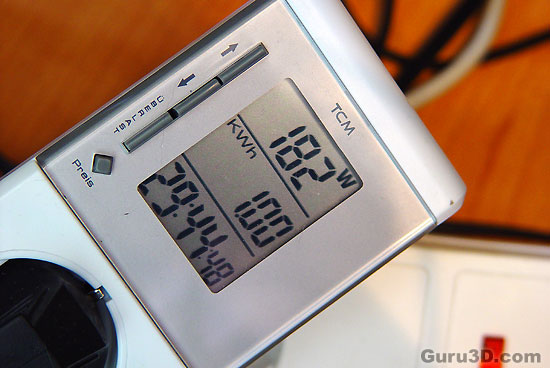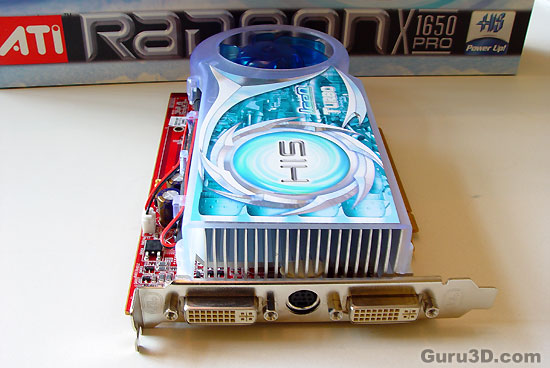Page 3
Think about mother Earth - Power Consumption
What we always do with new graphics' cards, we measure the wattage peak with the help of a wattage meter. Slight side note, you are looking at the overall usage of the entire PC. The meter is placed between the power connector and the PSU. So please understand that using a Wattage meter is not the most reliable way of measuring power consumption. This is how much power is being consumed, taking the measurement from the wall socket, and you need to look at the results as being an indication and not an exact science.
Let's have a look at some X1000 products and specifically the X1650 Pro product with regards to total PC power consumption:
|
|||||||||||||||||||||||||||||

I suggest you need a 350 Watt PSU minimum but better is always recommended especially if you keep Crossfire in mind as a future upgrade. When you buy a new PSU please look at the packaging and check amps on the 12 volts rail. 18 Amps should be fine for a mid-range PC.
Here are some indications on what would happen if your PSU can't cope with the load:
- unusual fluctuating 3D gaming performance
- crashing games
- spontaneous resetting PC
- freezes during gameplay
- PSU overload can cause it to break down or shut down.
Noise Levels coming from the graphics card ![]()
When graphics cards produce a lot of heat usually that heat needs to be transported away from the hot core as fast as possible. Often you'll see massive active fan solutions that can indeed get rid of the heat, yet all the fans these days make the PC a noisy son of a gun. I'm doing a little try out today with noise monitoring, so basically the test we do is extremely subjective. We bough a certified dBA meter and will start measuring how many dBA originate from the PC. Why is this subjective you ask? Well, there is always noise in the background, from the streets, from the HD, PSU fan etc etc, so this is by a mile or two not a precise measurement. You could only achieve objective measurement in a sound test chamber.
The human hearing system has different sensitivities at different frequencies. This means that the perception of noise is not at all equal at every frequency. Noise with significant measured levels (in dB) at high or low frequencies will not be as annoying as it would be when its energy is concentrated in the middle frequencies. In other words, the measured noise levels in dB will not reflect the actual human perception of the loudness of the noise. That's why we measure the dBa level. A specific circuit is added to the sound level meter to correct its reading in regard to this concept. This reading is the noise level in dBA. The letter A is added to indicate the correction that was made in the measurement.
|
| ||||||||||||||||||||||||||||||
|
Bedroom at night |
30 dBA |
Quiet | |||||||||||||||||||||||||||||
|
Broadcast studio |
20 dBA |
| |||||||||||||||||||||||||||||
|
Rustling leaves |
10 dBA |
Barely audible | |||||||||||||||||||||||||||||
We startup a benchmark, we take the dBA meter, move away 75 CM and then aim the device at the active fan on the graphics card. We measure roughly 45 dBa on the PC, which is to be considered a quiet to moderate noise level coming from the PC.
AVIVO (Advanced Video in and Out)
The media revolution? This is actually the headline used in their presentation. ATI's green friends have a lot of these features integrated already for a while now and wrapped most of it up under the PureVideo en/decoders.
As we all know, and as I've been preaching for a while now, we see the living room entertainment coming to the PC more and more in a very fast fashion. One of the most popular things we've noticed here in Europe has to be HDTV and everything related to it. The trend started last year already and hey even yours truly bought a HDTV in recent times. It's coming fast and quite frankly, thank God for that as watching content in HD is simply fantastic. How does that relate to graphics cards? In more ways then you think, just look at the latest trend of HTPC's, Home Theater PC's. Things like Media Center PC's here and there? Do you get where I'm going with this?
Yes exactly this kind of thing is what I am talking about. This is the future of media playback and the PC is going to play a very important role in that. Since it's a PC, you probably want a graphics card in there that can support all the cool and extensive features. Media playback and decoding is a process that can, is and will be moved towards the graphics card. Both NVIDIA and ATI already had excellent implementations of it. With exactly this kind of stuff in mind they introduced the new AVIVO feature. Avivo features according to the ATI website:
- Supports hardware MPEG-2 compression, hardware assisted decode of MPEG-2, H.264 and VC-1 video codecs, and advanced display upscaling
- 64 times the number of colors currently available in current PCs; higher color fidelity with 10-bit processing throughout Avivo´s display engine
- Resolutions, such as 2560x1600 or higher, on the latest digital displays using dual-link DVI, as well as high color depth support over DVI
- Advanced up or down resolution scaling on any flat panel display using ATI´s solutions
- Video capture with features like 3D comb filtering, front-end video scaling, and hardware MPEG video compression
- Hardware noise reduction and 12-bit analog-to-digital conversion
- Supports standard TV, HDTV, video input and all PC displays via digital (DVI, HDMI) and analog (VGA, Component, S-Video, composite) ports
Avivo will be an integral component in all of ATI´s upcoming desktop, mobile, chipset, workstation, and software products. As stated Media Center PC are getting really popular. TV is going digital and HD/HD2(?) Blu-ray and HD-DVD are coming. Digital photography is everywhere. AVIVO is a video and display platform that perfects the video quality. AVIVO will be integral in all future ATI products. Vibrant high fidelity images and video.
Smooth vivid playback. Flawless playback for both SD and HD television that's what this stuff is intended for from a decoding point of view. With two dual link DVI ports which are supported on the entire X1000 range, two High def screens can be connected.
I'm actually using the card as we speak and it's connected to two Dell 1920x1200 screens. It works perfectly.

The dual-DVI connectors allow a lot of connectivity. They both are Dual-Link, supporting resolutions up-to 2560x1600.
